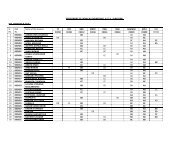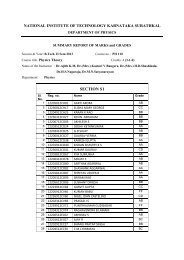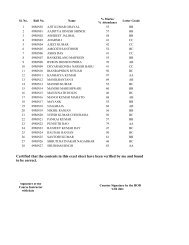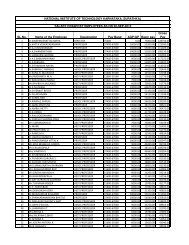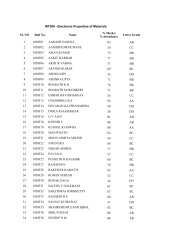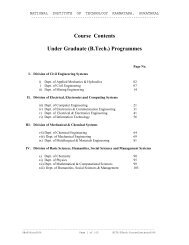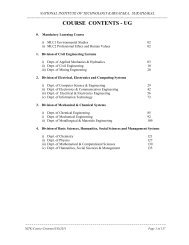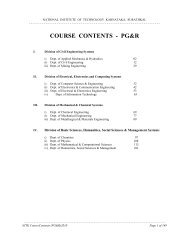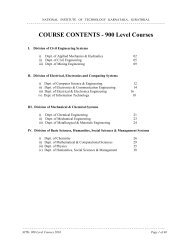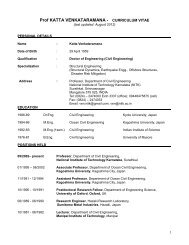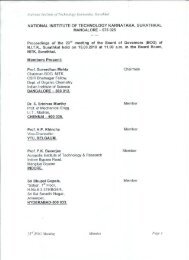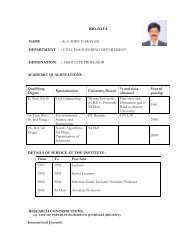course contents - ug - National Institute of Technology Karnataka
course contents - ug - National Institute of Technology Karnataka
course contents - ug - National Institute of Technology Karnataka
You also want an ePaper? Increase the reach of your titles
YUMPU automatically turns print PDFs into web optimized ePapers that Google loves.
NATIONAL INSTITUTE OF TECHNOLOGY KARNATAKA, SURATHAKAL<br />
------------------------------------------------------------------------------------------------------------------<br />
J.G.Proakis & M.Salehi, Communications System Engineering, Pearson Education 2002.<br />
Stevan M Kay, Fundamentals <strong>of</strong> Statistical signal processing, Vol. II, Detection Theory, PHI, 1998.<br />
A.Paulraj, R.Nabar & D.Gore,Introduction to Space Time Wireless Communications, Cambridge<br />
University, 2003.<br />
EC424 SOFT COMPUTING (3-0-0) 3<br />
Introduction to learning systems - Feed forward Neural Networks - Perception - Multilayer Perceptron<br />
propagation algorithm and its variants - Improving generalization by various methods.<br />
Recurrent Neural Networks - Hopfield net - Boltzmann machine and Mean field learning - solving<br />
combinational optimization problems using recurrent Neural Networks.<br />
Unsupervised Neural Networks. Competitive learning - Self organizing maps - Growing cell structures<br />
Principal component analysis. Basics <strong>of</strong> fuzzy sets. Genetic algorithms: Population based search<br />
techniques, evolutionary strategies, mathematical foundations <strong>of</strong> genetic algorithms, search operators,<br />
genetic algorithms in function and combinational optimization, hybrid algorithms, application to pattern<br />
recognition<br />
S. Haykin, Neural Networks : A comprehensive foundation, Pearson, 1999<br />
J. M. Zurada, Introduction to artificial neural networks, Jaico publishing, 1997.<br />
B. Yegnanarayana, Artificial Neural Networks, PHI, 1991<br />
EC425 DIGITAL SYSTEMS &COMPUTER ORGANISATION (3-0-0) 3<br />
Combinational Logic Design, Arithmetic Circuits. Sequential Logic Design, Finite State Machines.<br />
Memory, Introduction to Computer Architecture, Programming Model, Hardware Interfacing <strong>of</strong> Memory<br />
& Peripherals, Typical application <strong>of</strong> Microprocessors<br />
M. Morris Mano & Charles Kime, Logic & Computer Design Fundamentals, Prentice Hall, 2008<br />
M.Morris Mano, Computer System Architecture, Prentice Hall, 2007<br />
John P.Uyemura, A First Course in Digital Systems Design - An Integrated Approach, Brooks/Cole,<br />
2000.<br />
EC426 PRINCIPLES OF COMMUNICATION ENGG (3-0-0) 3<br />
Introduction to Analog and Digital Communication: Bandwidth and Information capacity, Transmission<br />
modes, Signal analysis, Noise considerations. Modulation and Demodulation concepts (AM, FM, PM),<br />
TDM and FDM concepts. Super Heterodyne receivers and Direct Conversion receivers, Color TV<br />
Transmission and reception. Digital and Data Communication: Sampling Theorem, Coding and<br />
Decoding, Pulse modulation, FSK, PSK Modem, Serial and Parallel interface, Computer Network<br />
configurations and Protocols; OSI Reference model; Internet Protocol; packet switching. Satellite<br />
communication: Orbital patterns, geostationary satellites, frequency band allocation. Optical Fiber<br />
Communication: Mode <strong>of</strong> signal transmission, signal source and detectors, attenuation and channel<br />
capacity. Digital Telephony, PSTN and Cellular telephony, Voice over packet.<br />
Wayne Tomasi, Electronic Communication Systems: Fundamentals thro<strong>ug</strong>h Advanced, Pearson<br />
Education, 2008.<br />
Kennedy, Communication Systems, McGraw Hill,1996<br />
Gary Miller, Modern Electronic Communication, PHI, 2008<br />
Andrew S. Tannenbaum, Computer Networks, PHI, 2003<br />
EC427 COMPUTER NETWORKS (3-0-0) 3<br />
Basics <strong>of</strong> circuit switching, packet switching, cell switching. ISO-OSI model, need for the model,<br />
reasons, advantages etc. Link layer & local area network, Computer network architecture, TCP/IP<br />
protocol suite, Routing protocols, Asynchronous transfer mode (ATM), Frame relay concepts, Wireless<br />
LAN, Multicasting, Internet security, Voice over IP (VOIP), Storage networks, Socket programming,<br />
IPV6, need for IPV6, addressing space, difference between IPV6 and IPV4 etc.<br />
D. E Comer, Internetworking with TCP / IP – Vol. I, Prentice Hall, 2006<br />
---------------------------------------------------------------------<br />
NITK-Course Contents(UG)2010 Page 52 <strong>of</strong> 134



